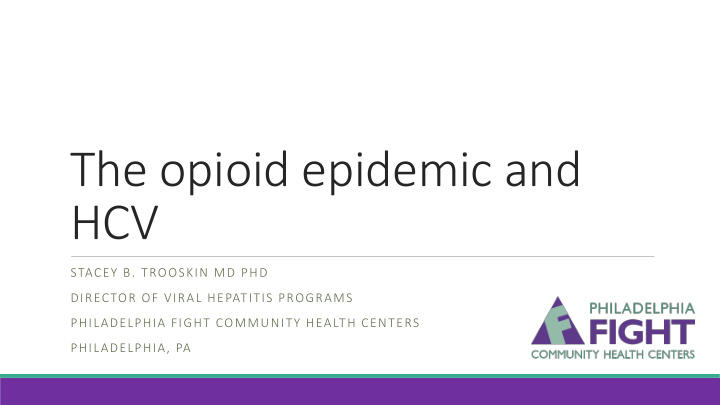



The opioid epidemic and HCV STACEY B. TROOSKIN MD PHD DIRECTOR OF VIRAL HEPATITIS PROGRAMS PHILADELPHIA FIGHT COMMUNITY HEALTH CENTERS PHILADELPHIA, PA
Philadelphia FIGHT COMMUNITY BASED TESTING Syringe Exchange Program Drug Treatment Programs The Jonathan Lax Treatment Center Homeless shelters The Youth Health Empowerment Project Opioid substitution programs The John Bell Health Center Senior Centers
A typical day in HCV clinic 24 yr old male Tested for HCV at syringe exchange program (SEP) Brought into clinic by HCV patient navigator On suboxone, 2 months off heroin Would like to be treated for HCV
His story Started experimenting with drugs at the age of 15 Prescription drugs (“ percs ”, “ oxys ”, “ xanies ”) Stated snorting heroin at age 19, injected age 21 Homeless at 22 Good health otherwise except for dental issues and depression
A new population of young HCV cases is emerging in Philadelphia 2007-2013 1000 1000 1000 1000 1000 1000 2013 2009 2007 2005 2003 2011 800 800 800 800 800 800 Number of Individuals 600 600 600 600 600 600 Count 400 400 400 400 400 400 200 200 200 200 200 200 0 0 0 0 0 0 1 3 5 7 9 111315171921232527293133353739414345474951535557596163656769717375777981838587899193 1 3 5 7 9 11131517192123252729313335373941434547495153555759616365676971737577798183858789919395 1 3 5 7 9 11131517192123252729313335373941434547495153555759616365676971737577798183858789919395 1 3 5 7 9 1113151719212325272931333537394143454749515355575961636567697173757779818385878991 1 3 5 7 9 11131517192123252729313335373941434547495153555759616365676971737577798183858789919395 1 3 5 7 9 111315171921232527293133353739414345474951535557596163656769717375777981838587899193 Age Data provided by Dr. Kendra Viner PhD from the Philadelphia Department of Public Health
http://www.cdc.gov/vitalsigns/heroin/
Two epidemics intertwined HCV infection is a serious health consequence of injection drug use ◦ HCV antibody prevalence among people who inject drugs is estimated to be 70 to 77% ◦ 1 of 3 people who inject drugs acquire HCV infection in their first year of injecting Syringe services and treatment for substance use disorder, essential parts of the response to the opioid epidemic, can also prevent transmission of HCV Part of the value of both opioid agonist therapy and SEPs is that they provide clients with an entry point to the health system Nelson et al., 2011 HHS, 2013 Volkow et al., 2014 Hagan et al., 2008 MacNeil and Pauly, 2011
Harm reduction services are necessary SEPs in the United States do not have sufficient coverage Evidence indicates that SEPs neither encourage new users nor increase drug use among clients Drug paraphernalia laws and regulations on the sale of syringes can impede the proper reach of syringe services ◦ Without such restrictions and with public funding, SEPs can distribute more equipment and offer complementary services, including HCV testing Des Jarlais et al., 2015 Bramson et al., 2015 Burris et al., 2002
Beyond Syringe Exchange Although legally prohibited in the US, supervised injection facilities, clinics where people can inject under clinical supervision, may be another means of harm reduction Supervised injection has been shown to reduce death from overdose ◦ Vancouver: 35% reduction in the rate of fatal overdose vs 9% reduction in other parts of the city Paul Yabor, 55 yo Coinfected with HIV and HCV Activist Drug Policy Alliance, 2016. Marshall et al., 2011
February 22 nd 2017, newsworks.org
May 19 th , 2017 Philly.com
Treating two epidemics Addiction is a chronic, relapsing disease of the brain Harm reduction, public health programs are needed ◦ Safe Injection Sites ◦ Syringe Exchange Programs ◦ Naloxone (Narcan) trainings and distribution ◦ Medication Assisted Treatment ◦ Suboxone ◦ Methadone ◦ Naltrexone (Vivitrol) HCV testing, linkage to care, and treatment ◦ Elimination of treatment restrictions ◦ Test and treat model of care ◦ Integrated models of care
Recommend
More recommend